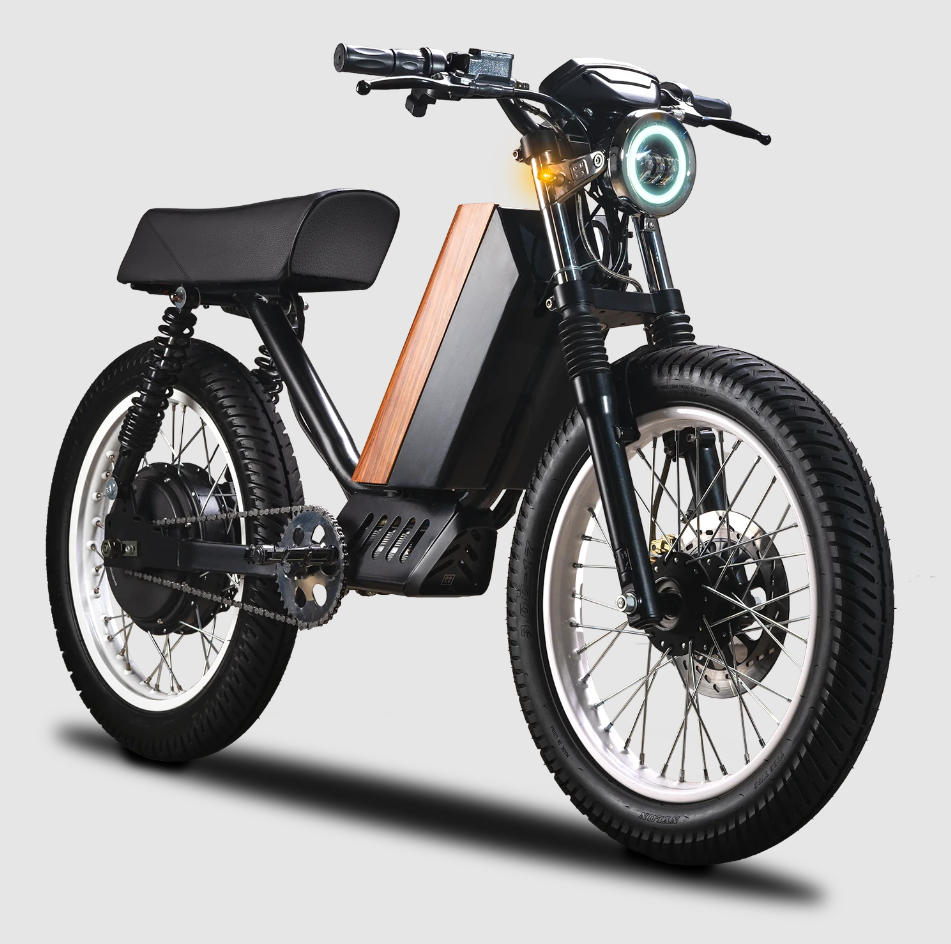Your Cart is Empty
Need help? Call us: 1-302-343-3950
Free Shipping To The Lower 48 Shop Now or call us at (302) 343-3950

One of the factors affecting an electric bike’s performance and usefulness is its weight. For instance, weight can help determine your speed, distance, and movability. Considering this, it’s important to do some research first even before buying one.
So, you ask, “How much do ebikes weigh?” Typically, an ebike weighs between 40-80 pounds. Although it differs depending on the type, battery and motor sizes, and materials used.
If you’re interested to know more regarding e-bikes’ weight and how it affects your performance, this article is meant for you.
If this concerns an ordinary bike, then normally, the lighter, the better. Of course, being lighter implies better handling and ease of use and movability.
But e-bikes are different, especially with the way they are built. The battery and the electric motor of electric bikes make them heavier compared to ordinary bikes. That ebike’s extra weight means it will be much easier to pedal and to maintain higher speed as long as the motor keeps on assisting you.
Thus, reducing the weight will compromise the motor and battery’s size and capacity. Less weight might mean less distance traveled. However, as bigger battery manufacturers enter the ebike market, some electric bikes can travel far despite reducing the weight.
An important factor to consider is how you plan to use the ebike. If you are using it for commutes in the city, a light weight ebike makes sense and likely the need for a powerful motor and large capacity battery is not so important, but if you're planning on longer distance riding a larger battery will be needed. The battery is what determines how far you can travel on motor power.
Heavier ebikes are usually those that need to house a powerful motor. Powerful motors are not only bigger and heavier, they put out so much torque (up to 170Nm of torque), that kind of pressure could actually flex the frame of a lightweight bike. So bigger and bulkier frames with a big powerful motor will land in the range of 70-80lbs but if you plan to go offroad (hunting for example), that's the ebike that will get the job done.
There are rare ebikes below 40 pounds that can still go far given their smaller batteries. But these rare finds come with a premium price as well. Usually because the frames are made from carbon fiber instead of aluminum and they house a smaller motor and battery.
So choosing based on your needs is vital.
You can read this Fat Tire eBike Review to find some great examples.

As previously mentioned, electric bicycles are built with batteries and electric motors, making them heavier than ordinary bikes. These bikes function well through electric assistance from batteries. In fact, about 20 pounds are being added to the electric bike’s weight due to its design.
Additionally, having wider wheels permit you to cycle through tougher terrains like snow and sand. But to do so, electric bikes need to have electric motors, which consequently implies additional weight.
Electric motors are needed as support to ebikes’ wider wheels because they make easier movement possible. This is important because without electric motors it will be harder for you to move the bike as the number of drag increases. Ease of movement is also the reason why only mountain bikes commonly have wider wheels in ordinary bikes.
An LCD, that allows users to control the power assistance level needed, is also an added feature in ebikes. Yet, in terms of weight, it commonly doesn’t add much.
The type of electric bike defines its use that likewise influences how much the ebike weighs. For example, if you wish to cycle as fast as possible, you’ll need a lighter bike, thus, a road bike would be best. But, if you want to handle tougher courses, mid drive, or go on hunting, mountain bikes are needed which are heavier due to its wider wheels.
Of course, having a background on the different e-bike types and how much do ebikes weigh is necessary to help you know which one fits you. With this, below is a list of the different types of ebikes and their corresponding estimated weights.

These are designed for easy storage and portability. If you’re looking for something that you can easily bring on trips or commutes, folding ebikes is the best choice. You can choose from the following variations together with their respective weights:

Commuting bikes, as the name suggests, are designed for comfortable commuting. They are also referred to as hybrid ebikes because of handlebars similar to a mountain bike and wheels that of a road bike. For traveling further distances, commuting ebikes have larger batteries, making them heavier with 50-70 pounds in weight. There are a lot of benefits of riding commuting bikes, learn more to find out if this is for you!
These are one of the expensive and lighter types, which usually weighs around 40 pounds. Racing ebikes are made with very thin wheels and frames, as well as, forward-curved handlebars. Given its design, you can cycle as fast as possible.

Mountain ebikes are expected to be quite heavier with 40-70 pounds but commonly at 70. As one of the most common types, these are designed both off-road and on the road. Also, the suspension is capable of reducing bumps’ impact and producing up to 750W power output.

Cruiser ebikes, weighing around 70 pounds, are meant to be used more for leisure. Its big soft seats and wide handlebars allow you to use it in a more relaxed manner compared to others.

Similar to mountain ebikes, fat tire ebikes are designed for off-road, tough terrain use like on sand or snow. With wider tires, fat tire bikes are commonly 60-80 pounds heavy.
Like cruiser ebikes, comfort ebikes are more commonly used for leisure. In terms of design, their handlebars extend backward rather than on the side. Usually, comfort ebikes also have a step-through frame and weigh about 50-70 pounds.
Let’s say, you really intend on buying an ebike. However, the extra weight still makes you think twice. What you need to do is to be clear on why you consider buying an e-bike in the first place.
If you want to commute long distances in the quickest way possible, then, the advantages exceed that extra weight. The electric motor on the ebike makes it easier to pedal even when it’s heavier. But, the weight can be a matter of concern if you’ll need to carry it.
Knowing how much do ebikes weigh is important. It gives you the idea of how to manage your ebike. Additionally, you can opt to choose the lightest ebike available. Although, be aware that getting the lightest ones may mean that you can’t cover a longer range. You may bring an extra battery if you want, but just the same, it’s extra weight.
Typically, a single charge can last for 20-50 miles and some light ebikes can last over 50 miles. But the range normally depends on the battery and electric motor sizes and on where your bike, for instance, off-road.
Also, make it a habit to clean your ebikes thoroughly as accumulated mud can add to the weight. Consider switching to thinner tires as well, but note that ease of cycling will compromise the grip. Besides, you can remove additional things you attached on your ebike, like bags.
Understanding the weight of e-bikes is crucial for assessing their performance and usability. Typically ranging from 40-80 pounds, an e-bike’s weight varies based on factors like battery size, motor power, and materials used. While lighter bikes offer better handling and maneuverability in traditional cycling, e-bikes differ due to their motor and battery weight, impacting speed and assistive capabilities Read the full article and comment on this, comment should be provide user value and within 5 lines:
.
I ride Haybike Race Max very good equipped e-bike for the price of $500 (48V/12.5Ah/h, 500W) and even if it’s with ergonomically-shaped bended lower and lighter frame (55 lbs), I’m considering a trade-in for step-through e-bike frame. I’m 75-yr of age senior and remember past time when step-through bike frames were marketed exclusively to female riders. The time changed in right direction and most of the step-through e-bikes today are sized for unisex, accommodating up to 6.2-6.5” toll riders. The devil is always in the details, however, for taller and male riders one needs mainly to pay attention for the distance (the reach) between saddle and handlebar, not exactly for the e-bike weight for comfortable ride. Most of the e-bikes today are heavier, above 50 pounds and up to 80 pounds when in fat tires mountain category, or so-called, cargo e-bike type. Good luck in picking the right frame e-bike for your age and abilities , so you’ll be not sorry and be forced like me to trade-in almost new step-over e-bike for step-through.
I used to be a very coordinated person. I have a step through e-bike that weighs about 65 lbs. I’ve had a knee replacement and I’m in my late 60s. I’m finding that it doesn’t take much to make me tip over and fall when I stop. The bike is so heavy that when it is unbalanced it hits my leg and takes me over to the ground with it. I’ve been practicing on this but I don’t think I have the strength to keep it up right when stopped. I’ve thought about strength training which I don’t like much but would do. I do need a step through and have read that most of these bikes are between 50 and 70 lbs. Does anyone have ideas or knowledge. I’ve got to be very careful when I ride and I have ordered knee pads and elbow pads. I’ve spent a fortune on this bike. What can I do?
I think you’ll probably be okay. I was just looking up the exact same thing a few minutes ago. Pedal bikes (NOT ebikes or motor bikes) weigh around 18 pounds each. This is a bicycle without a motor I’m talking about. My hitch bike rack will handle two of those. If you have a two bike carrier, you should be okay. If you really want to know though you can get on the manufacturer’s website and see what they say is the most weight it can take. I’m looking at ebikes and was wondering the same thing. Your Thule is likely capable of more weight than my Allen Sports carrier.
Will my Thule hitch bike rack “tolerate” a 50 lb e bike ??
Comments will be approved before showing up.
Mike Gilchrist
February 13, 2025
I have one of the heaviest ebikes you can buy. The Biktrix Juggernaut Duo 4 at 74 pounds without the battery. It also has commensurate power at 1000W, and enough battery to provide 100km range. And it is a very smooth ride.
It might be overkill for some people, but I’m 220 lb, and it is very comfortable.